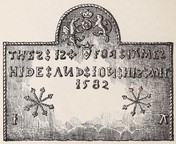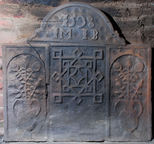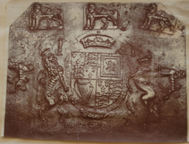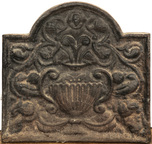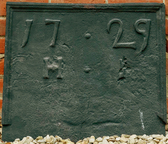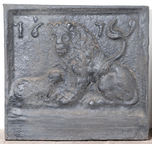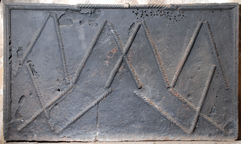-
473
Description: Arched rectangular shape; twisted rope edging (top and sides); in arch; rose and crown with dragon and lion supporters, above a fleur cross and a crowned shield bearing a small fleur-de-lys; text across top half, each word separated by two fleur terminals; lower left and right, twice repeated eight-pointed star design formed of twisted rope with fleur-de-lys terminals; bottom left, ‘I’; bottom right, ‘A’.
Notes: A James Hide married Joan Blackefane at Horley, Surrey on 11th October 1579; illustrated in Lower, 1849 p. 217, when it was at Sutton Hurst, Barcombe, Sussex (still there in 1893, house since demolished). One of a small series of distinctive firebacks cast in 1582, most with inscriptions dedicated to pairs of individuals; the initials IA may be of the founder as they appear in the same arrangement on other firebacks; the rose and crown and supporters stamp can also be seen on a large fireback, dated 1593, formerly at Baynard's Park, Surrey (no. 200).
Inscription: THES : IS FOR IAMES : / HIDE : AND : ION : HIS : WIF [W inverted] / 1582 / I A
- Decoration tags:
- rectangular with round arch (shape)
- rope (edging)
- carved stamps
- individual letters
- individual numbers
- heraldic
- text
- objects
Manufactured: in 1582 possibly at Pounsley Furnace, Framfield in the Weald area of England.
Current location: not known.
- Attached to series:
- Pounsley series
- 1582 IA series
- Fleur rope terminal series
- Fleur-de-lys firebacks
-
475
Description: Composite of three elements; central panel has a complex ‘knot’ pattern with a fillet edge; side panel, repeated on either side of the central panel, contains a vase of flowers, possibly stylised thistles, within an arched frame and fillet edge; arched panel above, also with fillet edge, contains the date and inscription; the spandrels of the side panels, and the arched top panel, contain a series of 'bullseye' motifs comprising concentric rings deepening towards the centre.
Notes: One of an unusual series formed from separate panels arranged, in this instance, with the outer panel repeated.‘Knot’ patterns were popular in gardens of the period. The garden theme is continued with the side panels. A version of the same design, recorded in a photograph of 1904 at Willesden, London, is a different casting, the top panel with the date and initials, being straight not slightly askew as in this example.
Inscription: 1598 / IM IB
- Decoration tags:
- rectangular with round arch (shape)
- astragal (edging)
- carved pattern panels
- text
- plants
- objects
Manufactured: in 1598 in the Weald area of England.
Current location: in private hands, Linchmere, West Sussex, England.
- Attached to series:
- Armada series
- Garden design types
-
1036
Description: Canted rectangular shape; no edging; lower centre, carved pattern panel of Stuart Royal arms: shield, garter, crown, motto, supporters and initials, RI separated by crown; lion statant guardant stamp repeated five times, three across top, one each side feet to left.
Notes: The impression of the decorative elements is irregular, with the achievement of arms under-pressed and the three lion stamps along the top over-pressed; the distinctive feature of the unicorn's horn in front of the initial R has been seen on a small number of other firebacks. The Stuart arms in the same style are seen on another fireback (no. 406). From a photograph in the J. Starkie Gardner Collection, Victoria & Albert Museum, Archive of Art and Design (AAD/2014/8).
Inscription: I R
Arms: English Stuart royal - James I
- Decoration tags:
- rectangular with canted top corners (shape)
- none (edging)
- carved stamps
- carved pattern panels
- heraldic
- armorial
- royal
- text
- animals
Manufactured: in the early-17th century possibly in the Weald area of England.
Current location: Maidstone Museum, St Faith's Street, Maidstone, Kent, England.
(part of the Maidstone Museum museum group)
-
1189
Description: Arched rectangular shape; cavetto-moulded edging; central, two handled, gadrooned vase with swirled, fruited vines issuing from the neck, and a bird on each side perched within the vines; out of the neck, a naïve human figure with arms outstretched, grasping vines on each side.
Notes: The figure emerging from the vase has a symbolism which has yet to be explained; more than one version of this fireback exists. Mallams auction, Abingdon, 28 Jun 2023, lot 219 (£60). Copies of this fireback were advertised in Kings Worthy Foundry's (Winchester) catalogue in the mid-20th century.
Copies of this fireback are known.
- Decoration tags:
- rectangular with round arch (shape)
- cavetto (edging)
- whole carved pattern
- animals
- humans
- plants
- objects
Manufactured: in the mid-17th century in the Weald area of England.
Current location: not known.
- Attached to series:
- Gadrooned vase firebacks
-
1241
Description: Rectangular shape; ovolo-moulded edging (top and sides); date across the top, separated by a bead; initials below date, also separated by a bead.
Notes: The moulded edging has been formed of mis-matched strips. The identical shape and size of the number '2' has been seen on another fireback of 1720. Mallam’s auction, Abingdon, 18 Oct 2022, lot 1122.
Inscription: 17 29 / H I
- Decoration tags:
- rectangular (shape)
- ovolo (edging)
- carved stamps
- individual letters
- individual numbers
- text
Manufactured: in 1729 possibly in the Weald area of England.
Current location: not known.
- Attached to series:
- 1720s Wealden series
-
1251
Description: Arched rectangular shape; twisted rope edging (top and sides); 'concentric' arrangement of 29 'grape bunch' stamps inside the rope edging, a further six inside them horizontally at the top; within those, five lengths of an undulating vine strip angled approximately to fit the curved shape; within them, 24 'grape bunch' stamps, with a single vine strip inside them horizontally at the top and a further line of seven 'grape bunch' stamps horizontally below that; below them, another vine strip horizontally; below that four vine strips placed vertically interspersed with three columns of five 'grape bunch' stamps.
Notes: Both the vine strips and the 'grape bunch' stamps are seen on other firebacks in the same series; the complexity of this arrangement of stamps is paralleled on a fireback recorded at Grayswood, Surrey (no. 72). Mallams auction, Oxford, 22 Feb 2023 lot 94 (£200).
- Decoration tags:
- rectangular with round arch (shape)
- rope (edging)
- simple stamps
- carved stamps
- objects
Manufactured: in the late-16th century possibly at Pounsley Furnace, Framfield in the Weald area of England.
Current location: not known.
- Attached to series:
- Pounsley series
- Vine strip series
- Furniture stamp firebacks
-
481
Description: Rectangular; cavetto edging all round; seated lion on right, its tail rising above its back and its head turned to face the viewer; a seated sheep on the left; at the bottom, a plain rectangular extension panel; date split across top.
Notes: Intended to represent the saying, ‘The lion shall lie down with the lamb’, a popular misquotation of Isaiah 11: 6.
- Decoration tags:
- rectangular (shape)
- cavetto (edging)
- whole carved pattern
- individual numbers
- extension panels
- pictorial
- biblical
- text
- animals
Manufactured: in 1679 in the Weald area of England.
Current location: in private hands, Maresfield, East Sussex, England.
- Attached to series:
- Small cavetto series
- Old Testament & Apocrypha firebacks
-
482
Description: Arched rectangular shape; rope edging (top and sides); Tudor royal shield, garter, crown and supporters (crowned lion and dragon); date split by crown; lower right, initial formed of twisted rope with fleur-de-lys terminals; small fleur-de-lys stamp repeated 14 times across top edge and arch; fleur-de-lys cross repeated six times across lower part of plate.
Notes: Identical arms can be seen on at least two other firebacks (no. 41 and no. 200); minor variations in the position of individual elements indicate that the garter and shield, crown, and each supporter were separately stamped. The lack of definition in the decoration suggests that this is a copy made from an earlier casting.
Inscription: 1595 / I H
Arms: Tudor royal - Elizabeth I
- Decoration tags:
- rectangular with round arch (shape)
- rope (edging)
- carved stamps
- armorial
- royal
- text
Manufactured: in 1595 possibly at Pounsley Furnace, Framfield in the Weald area of England.
Current location: in private hands, Maresfield, East Sussex, England.
-
484
Description: Fragment (right side only); rectangular; twisted rope edging (top and sides); concentrically grooved disc repeated four times in a square arrangement, with a rope cross between (probably mirrored on the missing half).
Notes: It has not been established from what the circular disc stamp has been derived.
- Decoration tags:
- rectangular (shape)
- rope (edging)
- simple stamps
- apotropaic
- objects
Manufactured: in the mid- to late-16th century in the Weald area of England.
Current location: in private hands, Hadlow Down, East Sussex, England.
- Attached to series:
- Miscellaneous stamp firebacks
-
485
Description: Rectangular; ovolo moulded edging (top and sides), except for middle section on top, where twisted rope is used; quasi-symmetrical arrangement of twisted rope lengths in two rows of alternate diagonals, crossing in the middle on the top row, and crossing on the outside on the bottom.
Notes: The section of rope edging on the top suggests that an arch had been removed from the base pattern board. The arrangement of rope lengths may have apotropaic significance, the double 'v' alluding to the Virgin Mary.
- Decoration tags:
- rectangular (shape)
- ovolo (edging)
- simple stamps
- apotropaic
- objects
Manufactured: in the mid- to late-16th century in the Weald area of England.
Current location: in private hands, Mayfield, East Sussex, England.
- Attached to series:
- Rope design firebacks
